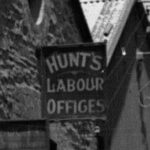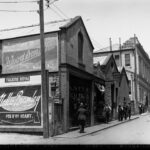The Wakefieldian plan that was the initial basis for the South Australian colony involved the creation of a particular type of social structure. Edward Gibbon Wakefield was alarmed by the situation of the convict colonies where the lower orders, even former convicts, were supposedly unwilling to work for landowners and could quickly become proprietors. Thus those who had brought capital to the colonies, largely derived from the middling orders in Britain, having no access to labour, could be reduced to the same social level as former convicts and labourers. To avoid this compressing of the social structure, he recommended that land be sold at a ‘sufficient price’ so that labourers could aspire to become landowners only after a long period of working and saving. Free passage to the colony for able-bodied labourers would ensure the supply of labour to capitalists. The lands upon which Wakefield’s plan was to carried out belonged to the Aboriginal people whose society was egalitarian and without a class structure.
In the earliest days, those men who came with some capital were able to secure large tracts of land as squatters or by purchase. In 1857 a number of lessees occupied more than 520km2, while Thomas Elder and his partner occupied 1040km2 and in 1864–65 Philip Levi leased 7410km2. Large squatters, who were able to buy land and consolidate their social position, dominated society and were more likely to be appointed as justices of the peace or to the Legislative Council. Some of their fortunes were repatriated to Britain, but many wealthy pastoralists built gracious houses on their properties and in Adelaide. Some, like the Elders, became landholders after making money in business. Wealth produced from the Burra Mine or at Broken Hill created great fortunes: JB Graham, a large shareholder in the Burra Mine, was said to have earned £16 000 in one year and to have left an estate of £200 000. But for struggling members of the middle class, like the family of Catherine Helen Spence, a few good mining shares could permit the maintenance of social respectability.
Landowners and workers
Nineteenth-century representations of South Australia often depicted a promised land for the hard working and thrifty, and the Victorian gold rushes did provide capital for some of the lower and middling orders to buy land and to set themselves up as yeomen farmers. This rather disparate but predominantly middling social order, of great social and political influence in South Australia, was widened by the Selection Acts of 1868–84 and by soldier settlement schemes of the twentieth century. Large pastoralists protected themselves from the selectors by buying up their runs. Although there were some 40 282 landowners in 1890, three-quarters held land worth less than £500, with almost half of these owning land worth under £50. But 169 had landed wealth of more than £20 000 and 24 had land worth over £100 000 each. This small group of families dominated South Australian society and politics well into the twentieth century.
An urban and rural working class was forming itself from the later nineteenth century. Working people were badly affected by any economic downturn, when they could be thrown out of work and become dependent on government rations. Workers developing a sense of class consciousness and solidarity demonstrated in favour of an 8-hour day from 1873. In 1882 some 2000 workers took part in the march and in 1890 some 8000 workers paraded in Adelaide and another 2200 at suburban Woodville Park. The growth of unionism among wharf labourers, shearers and other rural workers in the late nineteenth century alarmed the propertied. Even in the 1890s when class divisions were strong, some working-class organisations such as the Working Women’s Trade Union often included middle-class democrats, social reformers and philanthropists bent on helping the workers or civilising them. For much of the twentieth century, class conflict was not marked and organised labour was seen as ‘sensible and moderate’.
Banking and business (often associated with rural industries) furthered the development of a small urban middle class, but as rural interests were strong in the city, there was no ‘differentiation of the social structure into distinct agrarian and industrial classes’ (Holton, p561). The professions, particularly medicine, were greater sources of social status than business well into the twentieth century.
The Great Depression
The Great Depression (1927–39) affected South Australia particularly hard as a result of the low level of industrialisation. In 1933 around 16.6% of the state’s labour force was employed in manufacturing whereas 23.7% was in primary production. In the second quarter of that year, unemployment reached 35.4% of trade unionists, but 1933 census statistics show that over two-thirds of male wage and salary earners earned below the basic wage. Unemployment and underemployment were heavily concentrated in strong working-class areas like Port Adelaide where many worked on the wharves. While the depression had a devastating impact upon working people, it also reduced the ranks of small employers and the self-employed. However, shareholders and big business were much less affected and business mergers saw companies take over competitors.
The government’s industrialisation policy from the early 1930s through to the mid 1960s saw a growing urban working class and the relative decline of the agricultural labour force: 27.4% of the workforce were engaged in manufacturing and only 11.9% in primary production in 1961. Immigrants of non-English-speaking background were over-represented among manufacturing workers. The policy of industrialisation did not see the growth of a class of capitalist manufacturers. Rather, much of the capital was imported and the urban middle class workers were employed in professional, technical, managerial and clerical positions in public or private enterprises or were small business proprietors. Indeed the takeover of South Australian businesses, such as the Bank of Adelaide by the ANZ Bank in 1979, and the centralisation of corporate decision making to head offices in the eastern states and overseas saw control of the state’s economy move out of the state. The closure of the Stock Exchange of Adelaide in 1987 symbolised this trend.
The late twentieth century
From the 1970s the numbers employed in tertiary and community services increased as a proportion of the labour force. Holton notes that by 1981 this sector accounted for 19% of the labour force. The last decades of the twentieth century saw a process of virtual de-industrialisation and state governments struggled to maintain employment levels. At the beginning of the twenty-first century South Australia was recorded as having the highest level of poverty in Australia before housing costs were accounted for. Poverty rates had more than doubled since 1981. However, inequality was less marked than in other states, due to a smaller number of high-income households.
Aboriginal people have been economically at the lower levels of society throughout the contact period, and although some Aboriginal people gained well-paid positions in government, university or welfare service, they constitute only a small middle-class faction.
Discussion of social structure and class should not focus merely upon income and wealth but must also look to status, religion and ethnicity. Anglicanism and a British family heritage were almost essential to high status in the nineteenth and earlier twentieth centuries. Being a Roman Catholic or of a non-English-speaking background could be a bar to high social status until the final decades of the twentieth century.






Comments